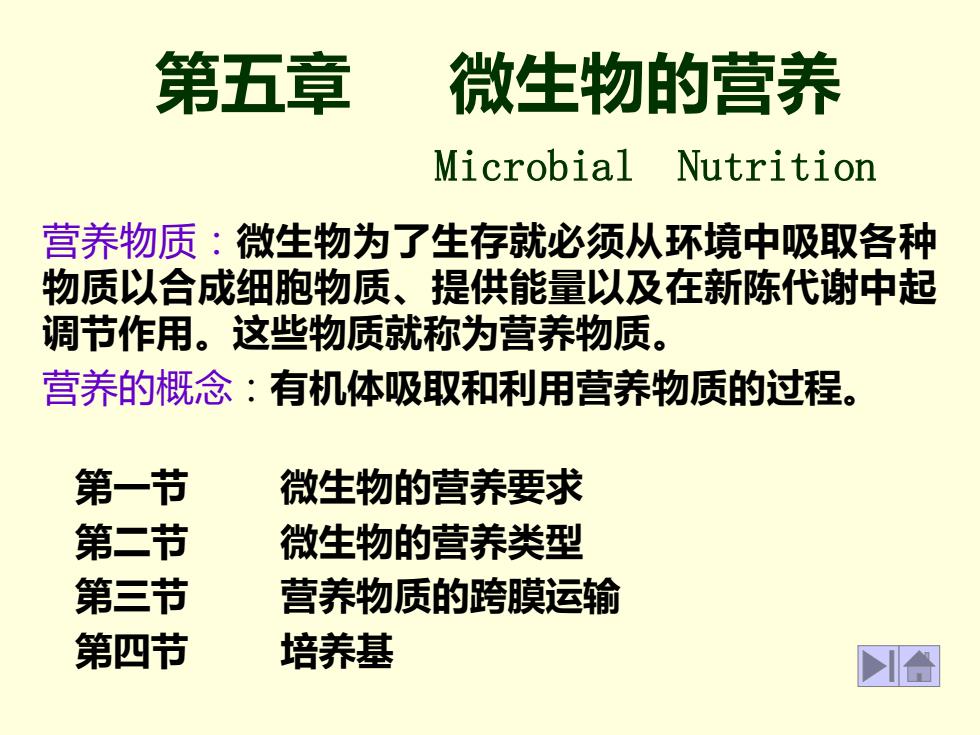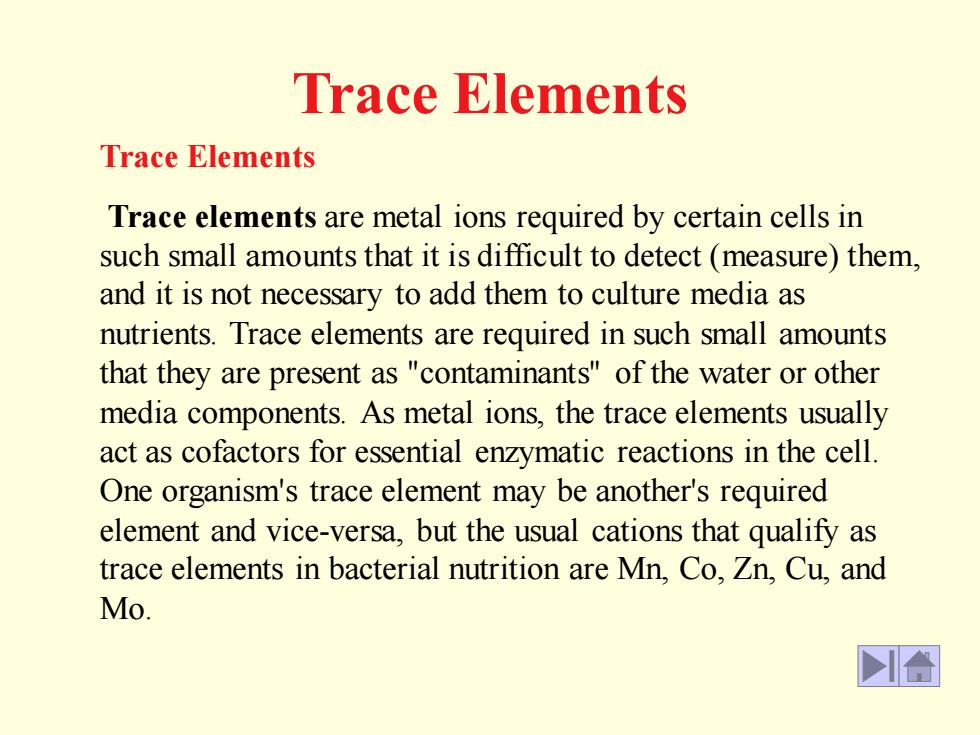
第五章 微生物的营养 营养物质:微生物为了生存就必须从环境中吸取各种 物质以合成细胞物质、提供能量以及在新陈代谢中起 调节作用。这些物质就称为营养物质。 营养的概念:有机体吸取和利用营养物质的过程。 第一节 微生物的营养要求 第二节 微生物的营养类型 第三节 营养物质的跨膜运输 第四节 培养基 Microbial Nutrition
第五章 微生物的营养 营养物质:微生物为了生存就必须从环境中吸取各种 物质以合成细胞物质、提供能量以及在新陈代谢中起 调节作用。这些物质就称为营养物质。 营养的概念:有机体吸取和利用营养物质的过程。 第一节 微生物的营养要求 第二节 微生物的营养类型 第三节 营养物质的跨膜运输 第四节 培养基 Microbial Nutrition

第一节 微生物的营养要求 一、微生物细胞的化学组成 二、营养物质及其生理功能 三、微生物的营养类型 Nutritional Requirements of Microbial Cells
第一节 微生物的营养要求 一、微生物细胞的化学组成 二、营养物质及其生理功能 三、微生物的营养类型 Nutritional Requirements of Microbial Cells

一、 微生物细胞的化学组成 (一)化学元素(chemical element): 大量元素(macroelement):碳、氢、氧、氮、 磷、 硫、钾、镁、钙、铁(其中前六种占细菌细胞干重的97%)。 微量元素(trace element): 锌、锰、钠、氯、钼、硒、钴、 铜、钨、镍 、硼。 元素 细菌 酵母菌 霉菌 碳 50 49.8 47.9 氮 15 12.4 5.2 氢 8 6.7 6.7 氧 20 31.1 40.2 磷 3 — — 硫 1 — — 表4—1 微生物细胞中几种主要元素的含量(干重%)
一、 微生物细胞的化学组成 (一)化学元素(chemical element): 大量元素(macroelement):碳、氢、氧、氮、 磷、 硫、钾、镁、钙、铁(其中前六种占细菌细胞干重的97%)。 微量元素(trace element): 锌、锰、钠、氯、钼、硒、钴、 铜、钨、镍 、硼。 元素 细菌 酵母菌 霉菌 碳 50 49.8 47.9 氮 15 12.4 5.2 氢 8 6.7 6.7 氧 20 31.1 40.2 磷 3 — — 硫 1 — — 表4—1 微生物细胞中几种主要元素的含量(干重%)

The Major Elements At an elementary level, the nutritional requirements of a bacterium such as E. coli are revealed by the cell's elemental composition, which consists of C, H, O, N, S. P, K, Mg, Fe, Ca, Mn, and traces of Zn, Co, Cu, and Mo. These elements are found in the form of water, inorganic ions, small molecules, and macromolecules which serve either a structural or functional role in the cells. The general physiological functions of the elements are outlined in the Table below
The Major Elements At an elementary level, the nutritional requirements of a bacterium such as E. coli are revealed by the cell's elemental composition, which consists of C, H, O, N, S. P, K, Mg, Fe, Ca, Mn, and traces of Zn, Co, Cu, and Mo. These elements are found in the form of water, inorganic ions, small molecules, and macromolecules which serve either a structural or functional role in the cells. The general physiological functions of the elements are outlined in the Table below

Trace Elements Trace Elements Trace elements are metal ions required by certain cells in such small amounts that it is difficult to detect (measure) them, and it is not necessary to add them to culture media as nutrients. Trace elements are required in such small amounts that they are present as "contaminants" of the water or other media components. As metal ions, the trace elements usually act as cofactors for essential enzymatic reactions in the cell. One organism's trace element may be another's required element and vice-versa, but the usual cations that qualify as trace elements in bacterial nutrition are Mn, Co, Zn, Cu, and Mo
Trace Elements Trace Elements Trace elements are metal ions required by certain cells in such small amounts that it is difficult to detect (measure) them, and it is not necessary to add them to culture media as nutrients. Trace elements are required in such small amounts that they are present as "contaminants" of the water or other media components. As metal ions, the trace elements usually act as cofactors for essential enzymatic reactions in the cell. One organism's trace element may be another's required element and vice-versa, but the usual cations that qualify as trace elements in bacterial nutrition are Mn, Co, Zn, Cu, and Mo

(二)元素在细胞内存在形式: 上述元素主要以水、有机物、无机盐的形式存在于细胞中: 1.有机物:蛋白质、糖、脂类、核酸、 维生素及其降解产物. 2.无机物:1)参与有机物组成, 2)单独存在于细胞质内以无机盐的形式存在. 3、水:约占细胞总重70%~90%,以游离水和结合水两种形 式存在 游离水:干重法可测得; 结合水:不易蒸发、不冻结、也不能渗透, 占水总量的17%—28%
(二)元素在细胞内存在形式: 上述元素主要以水、有机物、无机盐的形式存在于细胞中: 1.有机物:蛋白质、糖、脂类、核酸、 维生素及其降解产物. 2.无机物:1)参与有机物组成, 2)单独存在于细胞质内以无机盐的形式存在. 3、水:约占细胞总重70%~90%,以游离水和结合水两种形 式存在 游离水:干重法可测得; 结合水:不易蒸发、不冻结、也不能渗透, 占水总量的17%—28%

(三)微生物细胞化学组成含量的变化 主要成分 细菌 酵母菌 霉菌 水分 75~85 70~80 85~90 (占细胞鲜重的%) 蛋白质 50~80 32~75 14~15 占 细 碳水化合物 12~28 27~63 7~40 胞 干 脂肪 5~20 2~15 4~40 重 的 核酸 10~20 6 ~ 8 1 % 无机盐 2~30 3.8~7 6~12 表4—2 微生物细胞的化学组成 此组成可因菌种的种类、菌龄、培养基组成、培 养条件、分析方法等而有所不同
(三)微生物细胞化学组成含量的变化 主要成分 细菌 酵母菌 霉菌 水分 75~85 70~80 85~90 (占细胞鲜重的%) 蛋白质 50~80 32~75 14~15 占 细 碳水化合物 12~28 27~63 7~40 胞 干 脂肪 5~20 2~15 4~40 重 的 核酸 10~20 6 ~ 8 1 % 无机盐 2~30 3.8~7 6~12 表4—2 微生物细胞的化学组成 此组成可因菌种的种类、菌龄、培养基组成、培 养条件、分析方法等而有所不同

分析细胞有机、无机成分的方式 有机成分: 1. 化学法直接抽提-定性、定量分析 2. 破碎细胞,获得亚细胞结构-化学分析 无机成分: 细胞-550℃-灰分-定性、定量分析
分析细胞有机、无机成分的方式 有机成分: 1. 化学法直接抽提-定性、定量分析 2. 破碎细胞,获得亚细胞结构-化学分析 无机成分: 细胞-550℃-灰分-定性、定量分析

二、营养物质及其生理功能 碳源 氮源 无机盐 生长因子 水
二、营养物质及其生理功能 碳源 氮源 无机盐 生长因子 水

(一)、碳源(Carbon source) ◆定义:凡可被用来构成细胞物质或代谢产 物中碳素来源的营养物质。 ◆功能:提供合成细胞物质及代谢物的原料;并为整个生理 活动提供所需要能源(异养微生物)。 ◆种类: 无机含碳化合物:如CO2和碳酸盐等。 有机含碳化合物:糖与糖的衍生物(多糖:如淀粉、 麸皮、米糠等;饴糖;单糖),脂类、 醇类。有机酸、烃类、芳香族化合物 以及各种含氮的化合物
(一)、碳源(Carbon source) ◆定义:凡可被用来构成细胞物质或代谢产 物中碳素来源的营养物质。 ◆功能:提供合成细胞物质及代谢物的原料;并为整个生理 活动提供所需要能源(异养微生物)。 ◆种类: 无机含碳化合物:如CO2和碳酸盐等。 有机含碳化合物:糖与糖的衍生物(多糖:如淀粉、 麸皮、米糠等;饴糖;单糖),脂类、 醇类。有机酸、烃类、芳香族化合物 以及各种含氮的化合物